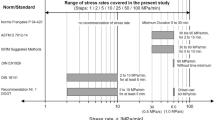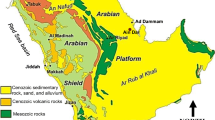Abstract
Amongst various index properties used by rock engineers, the uniaxial compressive strength (UCS) is probably the most widely used property of intact rocks. In the field, in situ stresses are always present, and, when samples are extracted from such rocks, the stresses are released. These specimens, when tested in the laboratory, may give low strength values in comparison to what would have been obtained without stress removal. It is difficult to exactly follow the stress path of coring of rock in a natural stress environment; an indirect way of simulating effect of stress removal has been adopted in this study. Specimens of a synthetic rock have been subjected to pre-loading with tensile stress, and qualitative assessment of the reduction in the laboratory UCS of the rock has been made. To induce tensile stresses, conventional Brazilian test apparatus was modified. The results indicate that if pre-loading tensile stress exceeds about half of the Brazilian tensile strength, stress removal has substantial effect on the UCS and conservative results may be expected from laboratory tests on rock specimens.








Similar content being viewed by others
References
Barton N (2002) Some new Q-Value correlations to assist in site characterisation and tunnel design. Int J Rock Mech Min Sci 39:185–216
Bieniawski ZT (1989) Engineering rock mass classifications. Wiley, New York
Corthesy R, Leite MH (2008) A strain-softening numerical model of core discing and damage. Int J Rock Mech Min Sci 45:329–350
Darlington WJ, Ranjith PG, Choi SK (2011) The effect of specimen size on strength and other properties in laboratory testing of rock and rock-like cementitious brittle materials. Rock Mech Rock Eng 44:513–529
Ghazvinian AH, Azinfar MJ, Vaneghi RG (2012) Importance of tensile strength on the shear behavior of discontinuities. Rock Mech Rock Eng 45:349–359
Goodman RE (1989) Introduction to rock mechanics. Wiley, New York
Haimson B (2009) A three-dimensional strength criterion based on three triaxial testing of rocks. In: Hudson et al. (eds), Proceedings of the SINOROCK2009, pp 21–8
ISRM, International Society for Rock Mechanics (1978) Commission on Standardization of Laboratory and Field Tests. Suggested methods for determining tensile strength of rock materials. Int J Rock Mech Min Sci Geomech Abstr 15:99–103
Kulatilake PHSW, Liang J, Gao H (2001) Experimental and numerical simulations of jointed rock block strength under uniaxial loading. J Eng Mech 127(12):1240–1247
Lanaro F, Sato T, Nakama S (2009) Depth variability of compressive strength test results of Toki granite from Shobasama and Mizunami construction sites, Japan. Rock Mech Rock Eng 42:611–629
Li D, Wong LNY (2013) Point load test on meta-sedimentary rocks and correlation to UCS and BTS. Rock Mech Rock Eng 46:889–896
Noferesti H, Rao KS (2010) New observations on the brittle failure process of simulated crystalline rocks. Rock Mech Rock Eng 43:135–150
Palmström A (1995) RMi—A rock mass characterization system for rock engineering purposes Ph.D. Thesis University of Oslo
Rajabzadeh MA, Moosavinasab Z, Rakhshandehroo G (2012) Effects of rock classes and porosity on the relation between uniaxial compressive strength and some rock properties for carbonate rocks. Rock Mech Rock Eng 45(1):113–122
Saidi F, Bernabe′ Y, Reuschle T (2005) Uniaxial compression of synthetic, poorly consolidated granular rock with a bimodal grain-size distribution. Rock Mech Rock Eng 38(2):129–144
Shen J, Jimenez R, Karakus M, Xu C (2013) A simplified failure criterion for intact rocks based on rock type and uniaxial compressive strength. Rock Mech Rock Eng. doi:10.1007/s00603-013-0408-5
Singh M, Rao KS (2005) Empirical methods to estimate the strength of jointed rock masses. Eng Geol 77(1–2):127–137
Singh M, Singh B (2005) A strength criterion based on critical state mechanics for intact rocks. Rock Mech Rock Eng 38(3):243–248
Singh M, Singh B (2012) Modified Mohr–Coulomb criterion for non-linear triaxial and polyaxial strength of jointed rocks. Int J Rock Mech Mining Sci 51:43–52
Singh M, Rao KS, Ramamurthy T (2002) Strength and deformational behaviour of a jointed rock mass. Rock Mech Rock Eng 35(1):45–64
Singh M, Raj A, Singh B (2011) Modified Mohr–Coulomb criterion for non-linear triaxial and polyaxial strength of intact rocks. Int J Rock Mech Mining Sci 48(4):546–555
Wawersik WR, Fairhurst C (1970) A study of brittle rock fracture in laboratory compression experiments. Int J Rock Mech Min Sci 7:561–575
Zhang L (2010) Estimating the strength of jointed rock masses. Rock Mech Rock Eng 43:391–402
Zhang XP, Wong LNY (2012) Cracking processes in rock-like material containing a single flaw under uniaxial compression: a numerical study based on parallel bonded-particle model approach. Rock Mech Rock Eng 45:711–737
Author information
Authors and Affiliations
Corresponding author
Rights and permissions
About this article
Cite this article
Singh, M., Lakshmi, V., Yudhbir et al. Effect of Pre-Loading with Tensile Stress on Laboratory UCS of a Synthetic Rock. Rock Mech Rock Eng 48, 53–60 (2015). https://doi.org/10.1007/s00603-013-0537-x
Received:
Accepted:
Published:
Issue Date:
DOI: https://doi.org/10.1007/s00603-013-0537-x




